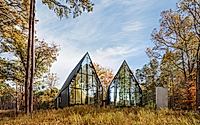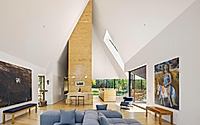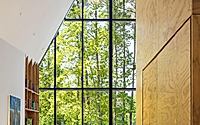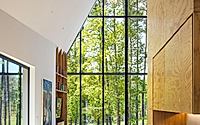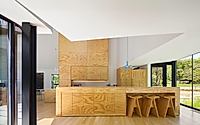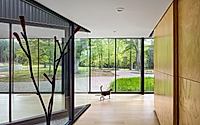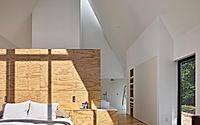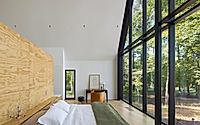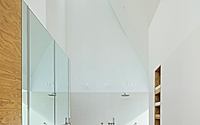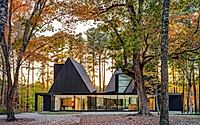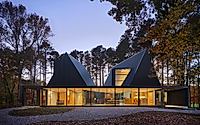Steeplechase House by Brooks + Scarpa
Brooks + Scarpa designed the Steeplechase House in Hillsborough, United States. Set in the Appalachian foothills, the house features double gable roofs and expansive windows that connect the interior to the surrounding forest.


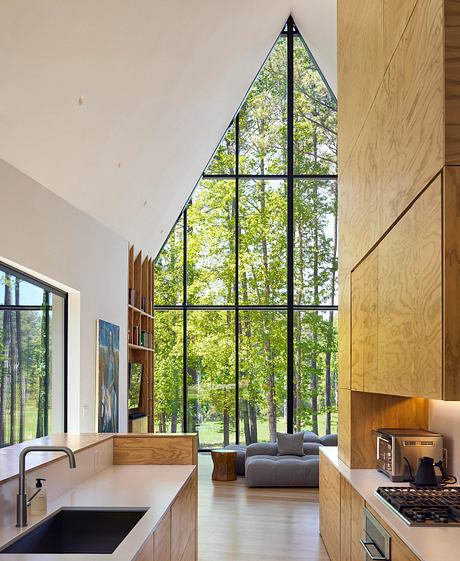

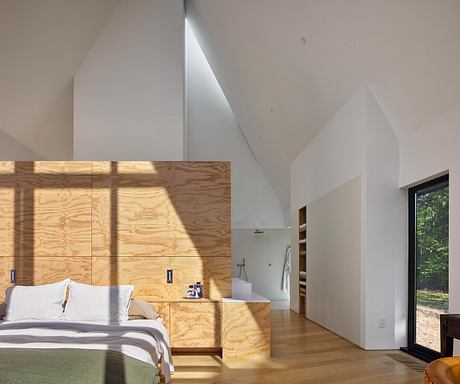



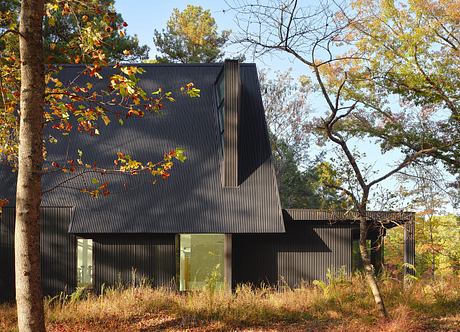

Client Impact Statement – Through its meticulously designed exterior, the residence encapsulates a harmonious blend of aesthetic appeal and sustainable living. The residence stands as a testament to innovative design that prioritizes the well-being of its occupants while minimizing environmental impact. The use of natural materials and strategic placement within its surroundings not only enhances the beauty and functionality of the space but also promotes a lifestyle that values eco-consciousness. This approach to design encourages a closer connection to nature, fostering a sense of peace and well-being for the residents. Furthermore, the residence’s sustainability features, as implied by its thoughtful exterior, contribute to a reduced carbon footprint, showcasing a commitment to environmental stewardship. The design of the residence offers a compelling example of how modern living can be both luxurious and aligned with the principles of sustainability and environmental care, setting a benchmark for future endeavors in residential architecture.
Statement of Design Excellence – Through an innovative incorporation of natural light, profound connection with nature, and meticulous use of natural materials, the new home was designed to conserve 98% of the existing 65-acre site, while harmoniously coexisting with its natural environment and ensuring minimal disturbance to the natural setting. The design seamlessly integrates large windows and strategically placed skylights, bathing interior spaces in natural light and fostering a vibrant connection between indoor living spaces and the outdoor environment. This architecture employs natural materials not only for their aesthetic appeal but also for their sustainability, enhancing the building’s ecological footprint.
The residence’s innovative reinterpretation of traditional gable roof forms, prevalent in the region, further demonstrates a commitment to design excellence. By blending these traditional elements with modern design principles, the residence creates a unique visual language that speaks to both heritage and innovation. This approach results in a building that stands in harmony within its natural setting, offering a forward-looking model for sustainable residential design, thus serving as a beacon of architectural innovation, showcasing how thoughtful design can enhance human and environmental well-being while respecting and revitalizing traditional forms.
Social justice, equity, diversity and inclusion – Benefits go beyond the immediate occupants by championing eco-friendly practices that positively impact the wider community. Utilizing 100% recycled metal and FSC certified wood products, the building sets a precedent for sustainable construction that mitigates environmental harm. These materials not only reduce the ecological footprint but also inspire local builders to adopt greener practices, fostering a culture of sustainability within the community. Additionally, by showcasing how aesthetically pleasing and functional eco-conscious materials can be, the residence encourages a shift in public perception, promoting environmental stewardship and well-being across the broader societal spectrum.
How does the project enhance equity among building occupants? Identify how the project promotes equitable communities?
The design promotes equity that the owners take car on property of abandoned animals ranging from dog and cats to horses, goats and other animals. Furthermore, the programming of the house allows for each occupant to have their own private spaces while also providing spaces that can be shared together.
Design for Ecosystems – The owners have put in place a plan to conserve and restore the 65-acre site to its natural habitat, supporting regional flora and fauna. No irrigation is provided on the site. All new planting foster habitat restoration but also enhance ecological health, setting a benchmark for future development in harmony with nature.
Design for Water – All stormwater is managed on site. Impervious surfaces are directed to on-site filtration. Water savings of approx. 38% above average due to low flow fixtures equates to substantial cost savings for both utility domestic and sewer water rates and payback time is less than 1 year.
Design for Economy – We prioritized both first and long-term costs and the need to have no or low maintenance costs for the future of the building. The design is a balance of economy and strategic enhancement. The design team worked with the general contractor throughout each design phase to identify opportunities for cost savings while maintaining a high-quality, durable, and sustainable design. The building systems were selected for their efficiency and ease of maintenance.
Design for Energy – The design incorporates an Energy Star MrCOOL 22.5 SEER heat pump, Rheem ProTerra 65-gallon smart heat pump water heater tht boasts a 3.85 Uniform Energy Factor (UEF) rating and qualifies for the Northwest Energy Efficiency Alliance (NEEA) Tier 4. comes from Philips, specifically their Ultra Efficient range. LED lighting is used that consumes at least 50% less energy than standard LED equivalents. They also have a long lifespan of 50,000 hours and are designed to meet the most stringent EU Ecodesign and Energy labeling regulations, with an efficacy of up to 210 lumens per watt (lm/w).
Large windows and skylights maximize natural daylight and cross ventilation, reducing the need for artificial lighting. The building is strategically placed to allow existing trees to block direct sunlight during the hottest parts of the day, minimizing cooling demands. High-quality insulation and energy-efficient glazing further reduce energy usage. A state-of-the-art energy management system monitors and controls lighting, HVAC that helps optimize energy usage and ensures that equipment operates at its most efficient levels.
Design for Well-being – The well-being of the residents is significantly enhanced by a thoughtful design centered around natural light and cross ventilation. By maximizing the infusion of natural light, the design promotes vitamin D synthesis and regulates circadian rhythms, fostering better sleep and mood. Cross ventilation ensures a constant flow of fresh air, reducing the reliance on artificial climate control, and contributing to a comfortable living environment. The exclusive use of natural, non-toxic materials eliminates off-gassing, safeguarding residents from harmful chemicals, enhancing indoor air quality, and directly benefiting respiratory health and overall well-being.
Design for Resources – The design includes a strong emphasis on sustainable material selections to create a durable, safe, and healthy environment, while also addressing equity and minimizing negative impacts on the planet. The project employs recycled and low-toxicity materials, ensuring a safe and healthy indoor environment for both residents and visitors. The project sources materials from suppliers and manufacturers who adhere to fair labor practices, fostering social responsibility and economic inclusivity.
Design for Change – The home is a model of passive survivability and adaptability, designed to maintain comfort and functionality in the face of changing climates and potential energy disruptions. Its energy-efficient design, enhanced by natural light and cross ventilation, ensures a livable environment even without active heating or cooling systems. The use of sustainable, durable materials anticipates future environmental challenges, allowing for longevity and reduced maintenance. Furthermore, the residence’s flexible design enables adaptation to evolving living requirements, ensuring that it remains a sustainable and comfortable haven for its occupants through changing times and conditions.
Design for Discovery – Strategic use of natural light creates dynamic shadows and illuminations throughout the day, inviting exploration and interaction with the space. Varied ceiling heights and open floor plans encourage curiosity, leading occupants through a journey within the home. Incorporation of natural materials and seamless indoor-outdoor transitions enhances connectivity with nature, offering serene vistas and fostering a deep sense of tranquility and wonder. These elements collectively craft an environment that captivates, comforts, and stimulates the senses, embodying architectural excellence.
Landscape Restoration – The newly constructed residential home in the Raleigh-Durham area of North Carolina represents a harmonious blend of modern living and environmental stewardship. In addition to the cutting-edge architectural design of the home, the project undertook a significant ecological restoration effort. Almost 20 acres of land previously overrun with non-native plant species were meticulously cleared and replaced with native flora. This transformation not only enhances the aesthetic appeal of the property but also fosters a thriving habitat for local wildlife. The introduction of native plants such as Eastern Redbud, Wild Bergamot, and Black-eyed Susan provides a rich source of nectar and pollen, attracting a variety of pollinators including bees, butterflies, and hummingbirds.
The ecological restoration has had a profound impact on the local biodiversity. The planting of native grasses like Little Bluestem and wildflowers such as Milkweed has created a welcoming environment for numerous insect species, including the endangered Monarch butterfly. Birds such as the Eastern Bluebird and American Goldfinch, along with small mammals like the Eastern Cottontail, have found sanctuary within this revitalized landscape. This project not only serves as a model for sustainable development but also underscores the vital role that residential properties can play in supporting and preserving local ecosystems.
EQ3: Baseline Energy Use Intensity (EUI) = 44
EQ4: Predicted Energy Use Intensity (pEUI) = 25.52
EQ5: Net Predicted Energy Use Intensity (nEUI) – 25.52
EQ6: Lighting Power Density (LPD) Baseline = 0.5
EQ7: Designed Lighting Power Density (LPD) = 0.28
EQ9: Provide a narrative of how All outdoor site vegetation is composed of local plant species with no permanent irrigation installed was implemented on the project.
The newly constructed residential home in the Raleigh-Durham area of North Carolina represents a harmonious blend of modern living and environmental stewardship. In addition to the cutting-edge architectural design of the home, the project undertook a significant ecological restoration effort. Almost 20 acres of land previously overrun with non-native plant species were meticulously cleared and replaced with native flora. This transformation not only enhances the aesthetic appeal of the property but also fosters a thriving habitat for local wildlife. The introduction of native plants such as Eastern Redbud, Wild Bergamot, and Black-eyed Susan provides a rich source of nectar and pollen, attracting a variety of pollinators including bees, butterflies, and hummingbirds.
The ecological restoration has had a profound impact on the local biodiversity. The planting of native grasses like Little Bluestem and wildflowers such as Milkweed has created a welcoming environment for numerous insect species, including the endangered Monarch butterfly. Birds such as the Eastern Bluebird and American Goldfinch, along with small mammals like the Eastern Cottontail, have found sanctuary within this revitalized landscape. This project not only serves as a model for sustainable development but also underscores the vital role that residential properties can play in supporting and preserving local ecosystems.
Photography by Mark Herboth
Visit Brooks + Scarpa
